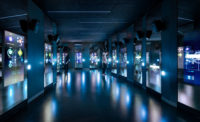Books for Your Holiday Gift List

Consider a book from our annual round-up for the architects on your gift list.
Drama, by David Rockwell with Bruce Mau, edited by Sam Lubell. Phaidon Press, 312 pages, $59.95.

Architect and Tony Award–winning set designer David Rockwell explores the relationship between architecture, interior design, and the performance arts through a series of engaging conversations with a dozen creative professionals across disciplines—among them New York Times architecture critic Michael Kimmelman, architect Daniel Libeskind, actor/playwright Anna Deavere Smith, and curator Thelma Golden. Illustrated with 300 photographs and drawings, this personal volume showcases a diverse range of projects designed not only by the author, but many others who have sought to create an aura of theatricality in their work. Linda C. Lentz
The Architecture of Health: Hospital Design and the Construction of Dignity, by Michael P. Murphy Jr., with Jeffrey Mansfield and MASS Design Group. Cooper Hewitt, Smithsonian Design Museum, 255 pages, $45.

MASS Design Group, known for purpose-driven architecture that promotes justice and collective healing, has been heralded for its inventive and transformative approach to health-care design across Africa and the Americas. Their community-focused work references the vernacular and uses local materials, as well as employing passive ventilation, daylighting, and connections to the outdoors. Published in the wake of the pandemic and the increased focus on healthy buildings, this book—illustrated with abundant photography and drawings—takes a critical look at the evolution of hospital design. Through this survey, which underscores how hospitals both reflect and influence their social and political environments, the authors—Murphy is founding principal and executive director of the not-for-profit firm, Mansfield is design director—hope to promote more effective, human-centered approaches to healing for the future. Beth Broome
Neri & Hu Design and Research Office Thresholds: Space, Time, and Practice, essays by Rafael Moneo and Sarah M. Whiting. Thames & Hudson, 352 pages, $65.

Thirty projects, ranging from historic restoration to retail, restaurant, and hotel spaces, by the Shanghai-based studio led by Lyndon Neri and Rossana Hu, a 2009 Record Vanguard, are beautifully presented in this volume, with numerous large-scale photos and drawings. The stunning work, published frequently in the pages of this magazine, offers unexpected solutions to age-old challenges in the context of modern globalism. Josephine Minutillo
OMA NY: Search Term, by Shohei Shigematsu and Jason Long, edited by Sophia Choi. Rizzoli, 676 pages, $85.

“Studying our studies slowly grew into an obsession” is how OMA NY partners Shohei Shigematsu and Jason Long (who, curiously, also interview artists David Byrne, Taryn Simon, and Virgil Abloh within the book’s pages) describe the process of assembling the 5,553 images, which document 13 years of study models, diagrams, construction photos, mock-ups, and social media posts across 23 projects built, lost, and in progress. Eric Höweler, AIA
Connection: CCY Architects, foreword by Rick Sommerfeld. Monacelli Press, 312 pages, $60.

This monograph of the Aspen, Colorado–based firm provides insight into how it investigates and formulates the connection between people and place. It uses 10 recently completed residential projects, located throughout the Rocky Mountain region, in both pristine nature and dense neighborhoods, to do so, sharing CCY’s process and the ideas, discoveries, and challenges that emerge. JM
Todd Saunders: New Northern Houses, by Dominic Bradbury. Thames & Hudson, 256 pages, $75.

The minimalist houses of Norway-based Canadian architect Todd Saunders are set in some of the most remote locations across Scandinavia and Canada. The tranquility and feeling of escape encapsulated in his designs—often rectilinear but sometimes fluid forms, highlighted here with stunning photography of snow-covered landscapes and dreamlike sunsets—is particularly resonant during this time. JM
MAD Rhapsody, by Ma Yansong, preface by Paul Goldberger, introduction by Philip Jodidio. Rizzoli, 288 pages, $75.

Founder of MAD Architects and one of China’s biggest design stars, Ma Yansong’s curvilinear, free-form, and futuristic designs—the Harbin Opera House in China, Absolute Towers in Canada, the Lucas Museum of Narrative Art in Los Angeles—are often compared to those of his mentor, Zaha Hadid, but his greatest inspiration is nature, albeit with attitude. “The work of MAD is like a rhapsody,” he writes. “The name MAD itself means madness, representing a rebellious and critical attitude.” JM
Two Hundred and Fifty Things an Architect Should Know, by Michael Sorkin. Princeton Architectural Press, $19.95.

Where materials come from. How to calculate the dimensions of a brise-soleil. The effect of the design of your city on food miles for fresh produce. How to listen closely. The exquisite corpse. Which way the wind blows. The history and techniques of architectural representation across cultures. The fine print in the contract. Chichen Itza. What to refuse to do, even for the money. These are just 10 of the 250 things the late architect, critic, and record contributor enumerates as essential knowledge for architects, in this compact and charming volume. JM
Strange Objects, New Solids and Massive Things, by Winka Dubbeldam / Archi-Tectonics, with contributions by Manuel DeLanda and Jonathan Jackson. Actar, 364 pages, $54.95.

After close to a century of Modernism as the prevailing approach to architecture, in the last two decades, the book argues, our widespread allegiance began to shift away from that “ism” toward a new social realm, and we have now reached a plateau where digital design and robotic production are the norm. The firm Archi-Tectonics, in particular, has long valued performance over form, design intelligence over style. As seen through an examination of 10 current and recent projects by the New York–based practice, founded by Winka Dubbeldam in 1994, this book celebrates the particular and singular over the ideal and universal. JM
Kengo Kuma: Topography, by Kengo Kuma and Associates. The Images Publishing Group, 298 pages, $75.

“My key focus throughout the 1990s was on making architecture disappear,” writes Kuma. “I had created topography instead of architecture.” His new volume explores in detail close to 40 recent high-profile projects, including work on Tokyo’s main stadium for the 2021 Olympic Games, the design of the V&A Dundee museum in Scotland, and Tokyo’s newest train station, as well as more human-scaled works, such as Jeju Ball resort in Korea, whose roofs are layered with a blanket of porous volcanic rock, and Wood / Pile meditation house, with its intricate wooden roofing and facade designed to allow patrons to experience the theatrical play of light as produced among the trees of its dense German forest setting. JM
Ernesto Nathan Rogers: The Modern Architect as Public Intellectual, by Maurizio Sabini. Bloomsbury, 220 pages, $99.

The British-Italian architect and critic Ernesto Nathan Rogers, whose role as a public intellectual after World War II was bolstered by his editorship of the journals Domus and Casabella-Continuità, has long lacked a comprehensive English-language study. Here, Maurizio Sabini offers a stimulating survey of Rogers’s architectural career within the prominent Milan-based collective BBPR (including his social engagement, and his insistence on teamwork and cross-disciplinarity), rescuing it from a neglect due to its nonorthodox version of modernism. Indeed, the result is to propose a work that might be seen as proto-postmodern. Throughout, Sabini accompanies his architectural analysis with quotations from Rogers’s writings. The selections, though, leave the reader asking for a fuller account of his work as an intellectual in the field, and the influence his built and projected work had on the cultural milieu (film, literature, and politics). Anthony Vidler
Frank Lloyd Wright and the Architects of Steinway Hall: A Study in Collaboration, by Stuart Cohen. ORO Editions, 316 pages, $35.

Of the myriad books that continue to proliferate on Frank Lloyd Wright, this investigation comes from a refreshingly different angle. Instead of romanticizing Wright as a pioneer and “lone genius,” Stuart Cohen, an architect and educator, places Wright as part of a coterie significant to the creation of Chicago’s architecture culture in the early 20th century. A specific venue enabled this social formation: Steinway Hall, designed in 1895 by Dwight Perkins and George Selby to house a showroom and offices for Steinway Piano, as well as provide workspaces that attracted a number of architects. Perkins’s own loft in Steinway was too large for him, so he brought in Robert Spencer, Myron Hunt, and Wright, each of whom had separate drafting rooms and offices but shared equipment and reception space. During the years they were suite mates (Wright was there in 1897, then again from 1901 to 1907), the four took the direction of architecture away from the 19th-century eclectic and classical styles toward a protomodern, individual, American response.
Cohen’s recounting of discussions and collaborations among them and others at Steinway Hall (where father-figure Louis Sullivan was a frequent visitor and where Marion Mahony worked for Perkins and Wright) gives a strong sense of the energized intellectual atmosphere. Spencer wrote frequently on architecture—including on Wright’s work—and Cohen makes an impressive case for the reciprocity of ideas between the two. As important are his biographies, in chapters devoted to Perkins, Spencer, and Hunt, and short takes on 11 firms, which together defined Chicago’s influence on American architecture of the time. Suzanne Stephens
Philadelphia Builds: Essays on Architecture, by Michael J. Lewis. Paul Dry Books, 373 pages, $22.95.

Michael J. Lewis is the architecture critic for The Wall Street Journal, an architectural historian, and a professor at Williams College in Massachusetts. He is also a native Philadelphian with degrees from Haverford College and the University of Pennsylvania. This series of essays on his hometown begins with William Penn’s role in a city where Quakers from England could live without persecution. Their avoidance of hierarchy, Lewis explains, led to the city’s gridded plan with open squares, as well as to the “disdain for pomp and display” in its architecture. While recent buildings by non-Philadelphians such as Frank Gehry, Tod Williams and Billie Tsien, and Robert A.M. Stern are included, the essays present welcome background on such Philadelphians as Owen Biddle, who wrote an influential 1805 how-to book on wood carpentry; the 19th-century idiosyncratic Frank Furness (whom Lewis explored in detail in his 2001 biography, Frank Furness: Architecture and the Violent Mind), as well as Louis Kahn. And of course there is Robert Venturi, whom the critic calls “the last Quaker,” citing the architect’s predilection for “accepting basic facts of modern life.” (Venturi actually was brought up as a Quaker.) This precept may make you think of the “new” Barnes Foundation: it seems to have accepted basic facts of modern life in its controversial move from the suburb of Merion to Benjamin Franklin Parkway. But while Lewis admires the craft, details, and materials of Williams and Tsien’s building, he’s not sure if its relocation ultimately will be seen as a “cultural crime.” For now, this reader finds it succeeds with a Quakerish charm—no pomp, no display, just solidity, imbued with light. SS
The Architecture of Milan: The City Written by Architects from the Post-War Period to the Present, edited by Marco Biraghi and Adriana Granato. Hoepli Editore, 495 pages, $55.

In Italian and English, this book beautifully presents, neighborhood by neighborhood, 150 of Milan’s most striking buildings—from Gio Ponti’s Pirelli Tower to SANAA’s new campus buildings for Bocconi University, and all the wonderful palazzi in between. Drawings and black-and-white photography by Sosthen Hennekam accompany each building, along with short texts, contributed by a roster of international scholars and architects that includes Mario Botta, Jean-Louis Cohen, Cino Zucchi, Winy Maas, Paolo Portoghesi, Ippolito Pestellini Laparelli, and Lorenzo Degli Esposti. JM






